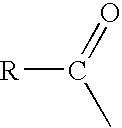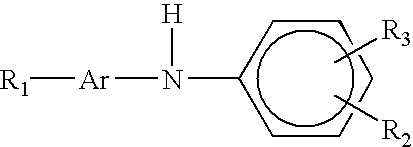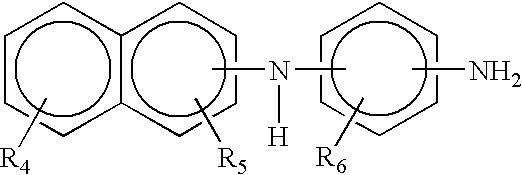Multiple-Function Dispersant Graft Polymer
- Summary
- Abstract
- Description
- Claims
- Application Information
AI Technical Summary
Benefits of technology
Problems solved by technology
Method used
Image
Examples
example 1
of Graft Polymer Preparation
[0295]A 500 ml resin kettle equipped with an electric heating mantle, stirrer, thermometer, metering syringe pump feed system and a gas inlet was charged with 400 grams of a 12.5% by weight ethylene-propylene polymer solution. The solution was prepared by dissolving about 50 gms of the polymer, Polimeri Europa CO-043 (Polimeri Europa, Ferrara, Italy) in 350 gms of a commercially available hydrorefined base stock, ExxonMobil EHC-60 (ExxonMobil, Fairfax, Va. 22037).
[0296]The gas inlet permits the gas to be fed either below or above the surface of the solution. The solution was heated to 170° C. and maintained at temperature throughout the preparation. During heating, the polymer solution was purged with an inerting gas (CO2) fed below the surface of the solution. When the solution reached the temperature of 170° C., the purge gas was redirected to flow over the surface of the polymer solution. The flow of the blanketing gas was maintained throughout the pre...
example 2
of Graft Polymer Preparation
[0299]A 2 liter reactor equipped with an electric heating mantle, stirrer, thermometer, metering syringe pump feed systems and a gas inlet was charged with 1000 grams of a 12.5% ethylene-propylene polymer solution. The solution was prepared by dissolving about 125 grams of the polymer, Polimeri Europa CO-043 in 875 gms of a commercially available hydrorefined base stock, ExxonMobil EHC-60.
[0300]The gas inlet permits the gas to be fed either below or above the surface of the solution. The solution was heated to 170° C. and maintained at temperature throughout the preparation. During heating, the polymer solution was purged with an inerting gas (CO2) fed below the surface of the solution. When the solution reached the temperature of 170° C., the purge gas was redirected to flow over the surface of the polymer solution. The flow of the blanketing gas was maintained throughout the preparation of the graft polymer.
[0301]A single charge of about 7.5 grams of ma...
example 3
of Graft Polymer Preparation
[0304]A 5 liter reactor equipped with an electric heating mantle, stirrer, thermometer, syringe pump feed systems and a gas inlet was charged with 3602.5 grams of a 12.5% ethylene-propylene polymer solution. The solution was prepared by dissolving about 450.3 gms of the polymer, Polimeri Europa CO-043 in 3152.2 gms of a commercially available hydrorefined base stock, ExxonMobil EHC-60.
[0305]The gas inlet permits the gas to be fed either below or above the surface of the solution. The solution was heated to 170° C. During heating, the polymer solution was purged with an inerting gas (CO2) fed below the surface of the solution. When the solution reached the temperature of 170° C., the purge gas was redirected to flow over the surface of the polymer solution and maintained throughout the preparation of the graft polymer.
[0306]A single charge of about 21.29 grams of maleic anhydride was added to the polymer solution and dissolved. This was followed by the con...
PUM
| Property | Measurement | Unit |
|---|---|---|
| Fraction | aaaaa | aaaaa |
| Fraction | aaaaa | aaaaa |
| Fraction | aaaaa | aaaaa |
Abstract
Description
Claims
Application Information
 Login to View More
Login to View More - R&D
- Intellectual Property
- Life Sciences
- Materials
- Tech Scout
- Unparalleled Data Quality
- Higher Quality Content
- 60% Fewer Hallucinations
Browse by: Latest US Patents, China's latest patents, Technical Efficacy Thesaurus, Application Domain, Technology Topic, Popular Technical Reports.
© 2025 PatSnap. All rights reserved.Legal|Privacy policy|Modern Slavery Act Transparency Statement|Sitemap|About US| Contact US: help@patsnap.com



